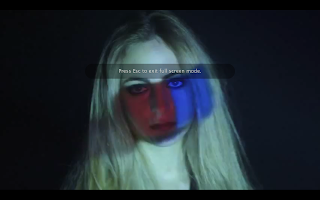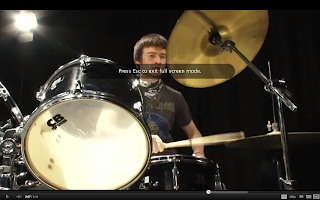To show the ways in which our music video utilises, develops and/or challenges the form and conventions of existing media texts I have chosen 6 stills from 'My Medicine'.
Firstly, this still conforms to the ultimate stereotypical band performance shot sononymous to rock music, in particular their music videos. The band shots are used to establish the members of the band and their location within the video. This is different from the more generic pop music video in which the focus is centered around the front man or woman, as an aspect of the male/female gaze their sex appeal is used in a promotional manner. Rock music videos are more focused upon the band due to a more instrumental and 'raw' star image many rock bands purvey. This image is further conforming to the stereotypes of the rock band set up, which consists of drummer at the center back, guitarists either side and the vocalist usually as the front of the frame. This is consist through many of the videos we researched including this still from the band VersaEmerge's music video (as shown below).
The next shot we chose subverts the dominant images within usual videos as it contains a video camera within the video. This was more of a plot device than a device of representation to show the singer and band creating their own propaganda, making the music video almost the perspective of the audience watching the propaganda. This helped build the narrative of the text.

This still to the left shows part of the abstract elements used within our music video. Abstract elements, albeit not used in all music videos are still contextually an existing convention within the rock genre, for example Radiohead's music video 'No Surprises'. However in our video this was our most powerful element; the images and readings being directly projected onto the character. This subverts more the more common ideology of music video as our abstract is pivotal with the narrative. They also related directly to the lyrics, in the case the pill and the lyric 'Somebody mixed my medicine'

The next still; a mid shot of the drummer mid performance, reflects a fundamental convention in rock music videos of the artists playing their instruments in sync with the track. This gives the illusion of the band playing in the music video. It is especially conformed to with rock music videos as the band are given a large amount of screen time for each member to establish their role and articulate their talent. This also acts as a promotional tool to some extent as each role or image represented for each band member can attract an audience, for example a particularly talented drummer shown within a music video can market the video towards the avid drummer and encourage them to watch it. Similarly an audience may begin to idolise a specific member and this can spark consumer debate over preference of band member generating more views and discussion of the video.

This still shows the narrative part of our music video which had the purpose of creating the storyline or stating the message. Music videos do not always tend to have narrative focus but instead are more reliant upon the abstract or performance shots. By creating our narrative that is a large focus of the video we challenged this stereotype. However the use of narrative within a music video is largely common within the rock genre, so it can be argued on the converse that this upheld the existing convention. Steve Archer comments that ‘Often, music videos will cut between a narrative and a performance of the song by the band. Sometimes the artist (especially the singer) will be a part of the story, acting as narrator and participant at the same time.' Our music video conforms to this fragmentation of character and narrative as our band members paradoxically flip between their state of work and their performance, a clear state of rebellion. To further this, we also used the singer as narrator and player in the video.
 This screen grab hi lights the more artist side to the music video, as a still projection. Keith Negus argues that the repetition of reoccurring thematic elements and generically specific iconography (one key element often being dominant and providing the skeletal structure for the promo) in music videos is commonly used. This applies to our music video from many different angles. For example, our consistent and frequent use of the projections show that are the basis of the video. However this can argued is not generically specific iconography as projections such as ours are largely unseen to those in other videos.
This screen grab hi lights the more artist side to the music video, as a still projection. Keith Negus argues that the repetition of reoccurring thematic elements and generically specific iconography (one key element often being dominant and providing the skeletal structure for the promo) in music videos is commonly used. This applies to our music video from many different angles. For example, our consistent and frequent use of the projections show that are the basis of the video. However this can argued is not generically specific iconography as projections such as ours are largely unseen to those in other videos.
Negus statement could also be loosely applied to the consistent colour palette of our music video. We kept the performance and narrative schemes to be dark and plain by using dim lighting to contrast the upcoming bold and bright projections that would become almost a stylized motif. Albeit dim or darkened lighting is common within the more heavy genres of rock music videos we challenged the codes and conventions of using more bright clear lighting to show more detail and focus the audience in on the meanings and images of projections.



No comments:
Post a Comment